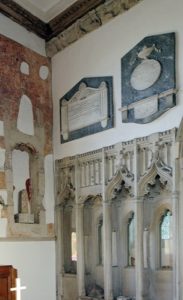The church is set on a hill above the village of Kersey. It is reached through a lych gate with grapes carved around the eaves. It has a large square flint tower with heavy flushwork buttresses and frieze around the parapet. There is a chequerboard flushwork design round the base of the tower. The nave is plastered with flint north aisle, chancel and porches.
The south wall of the nave is Norman, the rest is 14thC. Work stopped on the church after the Black Death and the tower wasn’t completed until the 15thC. The nave ceiling was raised, new windows added and the porches. The rood screen, glass and statues were destroyed in the Reformation. The nave and chancel had a make over in the 19thC.
The south porch has an elaborate flushwork front, reflecting increased wealth in the 15thC. Inside is a beautifully carved panelled roof.
Inside the church, walls are plastered and elegant octagonal pillars with pointed arches with carving separate nave and north aisle. The arches on the aisle side have carvings of bunches of grapes and flowers. There is the remains of a decorative frieze round the top of the north wall. The nave and chancel have a 15thC hammer beam ceiling but the angels lost their heads during Reformation. The north aisle has a plastered ceiling with beams across. The four panels over the north alter display the arms of the local Sampson and Thorrowgood families. Their memorials decorate the walls. Small hatchments are displayed between the arches in the north aisle.
The 15thC font inside the south door had quadrifoils round the base with angels and roses round the bowl. The remains of the bowl of the 12thC font are near the north altar. This had been used as a cottage door stop before being returned to the church.
The carved wood lectern is 15thC German work.
There is a simple high altar with a modern carved stone reredos behind.
Displayed in the north aisle is part of the base panels from the 15thC rood screen with painted images of prophets holding scrolls and kings set under Quadrifoil arches. King Edmund is holding an arrow. There is a three seated sedilia and piscina.
There are remains of wall paintings on the walls of the north aisle but it is difficult it make out details, apart from a kneeling figure.
There are niches on either side of the east window in the north aisle. One contains the headless figure of St Anne; the other a fragment of what could have been a cross.
This felt a strange church inside and a strange mish mash of styles and ideas which didn’t quite gel for us. The Victorian make-over didn’t extend to the north aisle and we felt the church wasn’t quite sure what to do with it. It is worth a quick look if in the area, but we felt it didn’t deserve the 1* rating given it in Jenkin’s “Engand’s Thousand best Churches”.
The church is open and there is parking in the school car park next to the church.










